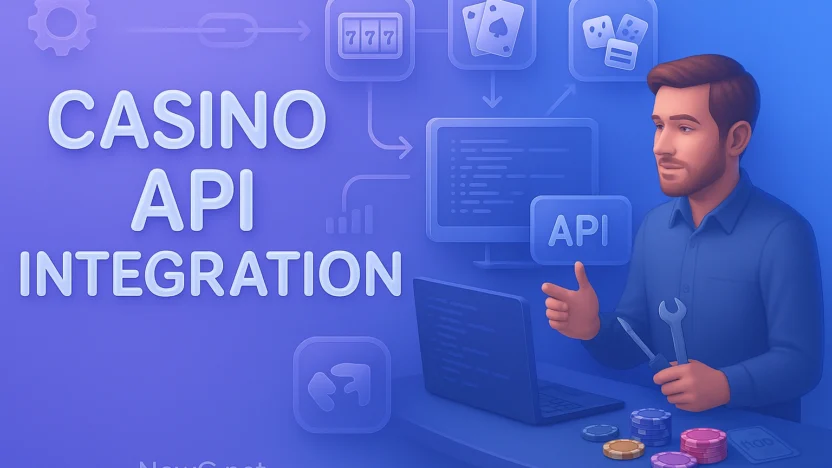“Plug-and-play” sounds easy—until your payment gateway crashes mid-spin and VIPs vaporize.
At NOWG, we’ve sat in too many war rooms where an operator’s roadmap buckled because systems refused to talk. Casino APIs change that game by welding every service—games, wallets, analytics—into one near-real-time nervous system.
Miss this train and you’ll watch rivals sprint ahead while you debug legacy code.
What Is a Casino API?
Think of an API as a translator that lets your platform and any third-party service whisper in the same language. A player hits “Spin,” the game engine fires data through the API, the wallet confirms balance, and the result shoots back—all in milliseconds. No manual sync, no stale data, no “please refresh” agony.
Why API Integration Matters
Direct Payoffs
| Benefit | Real-World Impact | Revenue Signal | Hidden Bonus |
|---|---|---|---|
| Single Sign-On | One login across sportsbook, slots, live tables | +8 % session length | Fewer forgotten-password tickets |
| Multi-Rail Payments | 150+ currencies & tokens auto-routed | +8% session length | Lower chargeback ratio |
| Live Data Feeds | Instant odds & jackpot pools | +11% conversion | Trust bump—players see transparency |
| Automated KYC | API-driven ID checks in <60 s | +17% in-play handle | -35% onboarding drop-off |
Notice the pattern? Every gain compounds: friction drops, engagement climbs, and operational cost slides.
Better UX, Bigger Wallets
APIs hand you customization superpowers. Want dynamic themes that match a player’s preferred team colors? Push a JSON payload. Need tailored bonuses after someone’s tenth blackjack? Trigger the bonus engine API. The smoother and more personal the ride, the more often players loop back—plain math, not magic.
It’s absolutely critical—absolutely critical—to keep latency invisible. If game switchover lags beyond 400 ms, churn risk skyrockets. Have you benchmarked your current stack on mobile 4G during peak Saturday nights? Most operators haven’t—and they pay for it in silent exits.
Backend Efficiency = Profit
Let’s be blunt: staff hours vanish when devs hand-code integrations. A mature API layer automates data sync, loyalty triggers, and even fraud alerts:
- Data orchestration—player stats, bet history, and marketing tags flow into one lake.
- Task automation—bonus emails, loss-limit warnings, and VIP tier upgrades fire without human clicks.
- Insight loops—real-time dashboards expose profit leaks before they swell.
That trio slashes overhead while freeing talent for growth projects, not patchwork.
Integration Roadmap
Tech details differ per vendor, yet six milestones repeat:
- Business Scoping – Define goals: extra payment rails? new jackpot aggregator? Clarity now saves rework later.
- Tech Alignment – Audit frameworks, data formats, and security policies. Your API can’t speak a language your stack doesn’t understand.
- Commercial Terms—Lock fees, SLAs, and exit clauses; rev-share creep kills margins faster than bugs.
- Build & Test – Code the calls, sandbox transactions, and hammer load tests. Break things early.
- Custom Polish – Skin the UI, tune bonuses, and localize content. Brand consistency equals trust.
- Go-Live & Support—Monitor logs like a hawk; hot-patch latency spikes before players tweet them.
Skipping even one step courts disaster—trust us, the postmortems are ugly.
Picking the Right API Partner
Choice paralysis is real—hundreds of providers shout “best.” Filter ruthlessly:
- Service Fit—Does the catalogue cover your must-have games, payments, and analytics?
- Tech Match—Confirm language, framework, and data-format compatibility.
- Delivery Track – Study past launches; missed deadlines now usually mean chaos later.
- Proof of Value—Dig into case studies and genuine reviews, not recycled press releases.
Only after a provider checks every technical and business box should contracts fly across the table.
Testing Checklist
Sandbox passes are fine for demos; production stakes real cash. Before you flip the switch, run this gauntlet:
- Load Spike Drill—Simulate Champions League overlap at 10× expected concurrency. If the wallet API groans past 250 ms, raise the red flag.
- Failover Flip—Yank primary DB connections mid-spin. Balance and bet state must recover in one round, or trust tanks.
- Payment Loopback—Push refunds through every rail, including that obscure e-wallet your CFO added last minute. Missing callback? Fix it now.
- Version Freeze – Lock API spec for launch week. Nothing derails QA harder than a “small” schema tweak.
Honestly, nothing here is rocket science—yet half the post-mortems we audit trace back to a skipped test script.
Performance KPIs
| KPI | Acceptable Threshold | Why It Matters | Red Alert Trigger |
|---|---|---|---|
| Average Game Load | <400 ms | Keeps bounce rate low | >600 ms for 5 min |
| Wallet Round-Trip | <250 ms | Prevents double-bets | >350 ms spike |
| API Error Rate | <0.1 % | Protects uptime SLA | >0.5 % in hour |
| Jackpot Sync Lag | <5 s | Maintains trust | Drift >15 s |
| Session Persistence | 99.95 % | Saves VIP wagers | 99.95% |
Keep dashboards live. A dormant metric can’t warn you.
Hidden Cost Traps
- Uncapped Calls—Some vendors bill after X million hits. Micro-betting explodes call volume; negotiate a ceiling.
- Feature Gating—Fancy bonusing API free at first, premium later. Price escalates once you’re locked in.
- Geo Routing Fees – Extra cents per transaction when traffic leaves EU nodes. Multiply by peak nights and watch OPEX swell.
- Emergency Support – “24/7” often means email queue unless you pay priority. Clarify response windows in writing.
Have you modeled year-three costs with 5× traffic? Most budgets stop at launch-year optimism—finance won’t like the surprise.
Security & Compliance
Regulators don’t care that your devs were “moving fast.” They want:
- TLS 1.3 everywhere—no mixed-content loopholes.
- HMAC-signed callbacks—prevents spoofed jackpot wins.
- Data minimization—only store what audits demand and purge on schedule.
- Automatic SAR triggers—hit the AML threshold, file within 24 h, no excuses.
Slip once and headline writers sharpen knives. Ask the provider for the last audit results; if they stall, walk.
Vendor Scorecard
| Question | Ideal Answer |
|---|---|
| Can we export full player history nightly? | “Yes, S3 bucket or FTP.” |
| Do you support webhooks and polling? | “Both—pick your poison.” |
| Latency from EU West to US East? | “Under 180 ms median.” |
| SLA credits for downtime? | “1 day fee per hour.” |
| Roadmap visibility? | “Quarterly call, public Trello.” |
If you’re hearing maybes, keep shopping.
Future-Proof Moves
Headlines fade, architectures linger. If your casino stack can’t swap out a payments API or bolt on a new crash game in an afternoon, you’re building technical debt faster than your progressive jackpots climb.
Architecture Decision Matrix
| Choice | Upside | Gotcha | When to Pull Trigger |
|---|---|---|---|
| Micro-services | Independent deploys, fault isolation | DevOps overhead | Multi-country, multi-brand rollouts |
| Headless Front End | UX A/B in days, not sprints | Extra latency hops | Marketing runs rapid-fire campaigns |
| Event Bus (Kafka/NATS) | Real-time streams for ML | Steeper learning curve | You push dynamic odds & live jackpots |
| Tokenised Player IDs | Cross-brand single wallet | Mapping legacy data | Planning interstate liquidity pools |
| Serverless Functions | Burst scaling on promos | Cold-start spikes | Flash-sale bonuses, micro-bet floods |
Notice how every upgrade reduces coupling. Tighter coupling means slower pivots—that’s lethal when a rival launches instant cash-out and your roadmap says “Q3.”
Tokenisation: Fraud’s Worst Enemy
Traditional user IDs leak context—handy for fraud rings. Tokenize the identity once, store the mapping off-platform, and suddenly credential-stuffing scripts choke. Side benefit: compliance audits love a system where personal data can be nuked without mangling bet history. Have you priced the PR fallout of a data breach lately?
Predict-and-Patch Churn Model
Forget generic DAU. Feed your event bus into a gradient-boost model scoring:
- Spin Cadence Drift – player slows from 9 spins/min to 6.
- Deposit Delay—deposit gap exceeds personal 90-day mean.
- Bet Diversity Dip—fewer than four game types in a week.
Hit two triggers? Fire a micro-bonus via webhook. Operators trialing this saw a 3-point bump in 30-day retention with zero extra promo budget. That’s pure margin.
Ops KPIs the Board Actually Cares About
| KPI | Board Question | Magic Number |
|---|---|---|
| Gross Gaming to OPEX Ratio | “Are we scaling efficiently?” | ≥ 4.5 |
| Mean Time to Recovery | “How fast after an outage?” | < 5 min |
| API Call Cost per 1 000 | “Are vendor fees bleeding us?” | <$0.15 |
| Churn Lift Saved by ML | “Did data science pay off?” | > 8 % |
Skip vanity metrics; the board reads EBITDA, not page views.
Real-World Snags Nobody Posts on LinkedIn
- Compliance Patch Lag – The new AML rule drops Friday, and the vendor patch ETA is Wednesday. Buffer with feature flags or brace for fines.
- Shadow Feature Debt—Sales promised “personalized reel sets” that engineering never scoped. Document or drown.
- Over-eager Marketing—Promo flash mobs swamp the wallet API; throttle or autoscale, your choice.
Let’s face it—every operator trips on the same cracks. The winners install guardrails before the sprint, not after the post-mortem.
Closing Thought
If regulators demanded proof today that every wallet, game server, and bonus engine could rotate keys and fail over in under ten seconds, could you nod confidently—or would you scramble? Answer that, and you’ll know exactly where to aim your next integration dollar.
Stress-test the answers with NOWG’s free casino tools—latency pings, churn predictors, and cost simulators. One dashboard, zero cost, instant clarity.




